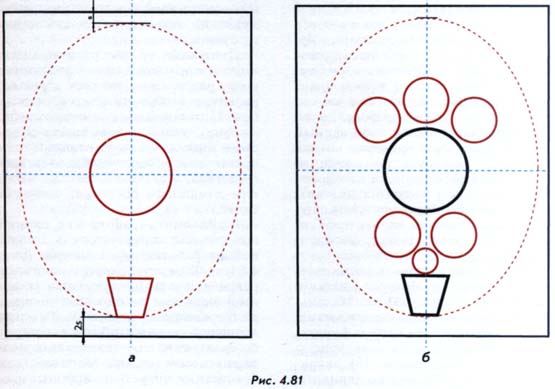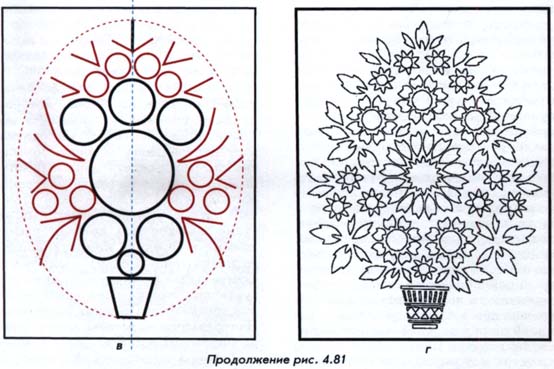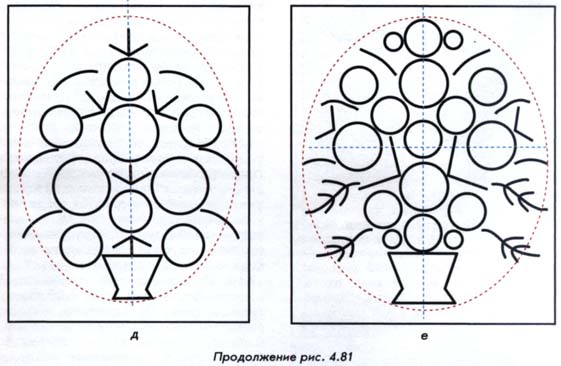Decorative panels is one of the means of interior decoration. His song provides the emotional and psychological impact on people, gives a unique individual features living room, office or another room. As an object of decorative art, murals support and emphasize his subjects generalized the beauty of flowers, animals, people with emphasis added aesthetic image.
Conceiving the subject decorative panel, the authors primarily focus on its positive emotional impact.
Consider the order of development of the composition and painting "Bouquet" technique of curvilinear applications.



1. Getting started with sketch working out the composition. The size composition 15x20 cm On a sheet of paper will watertite a rectangle with sides 15 and 20 cm (figure 4.81). Select a traditional Belarusian folk art type symmetrical composition. Draw a vertical axis of symmetry and symmetrically relative to the axis define a composite spot or approximate silhouette of the future of the bouquet. For the selected rectangular surface patch will have an oval shape. The location of the spots has its own regularities, its vertical position must be shifted up a bit: it has to do with the perception of the human eye the middle of the song. You can determine the position of the composite spot relative to the top and bottom: space between bottom margin and bottom border of the composition should be twice the clearance between the upper margin and the upper border of the composition (figure 4.81). For our example the distance is approximately 8 cm below and 4 cm at the top.
Composite spot has to be on a plane so as not to arouse the feeling of his stiffness, tightness within the surface or excessive freedom.
2. The development of the composition begin with constructing a schema that will show the location of the main and complementary elements. Determine the area of the Central element of the composition. The surface of the panels is small, so as the Central element, select a single large flower, conventionally shown in the diagram by a circle, which is located in the middle of the composite spot (figure 4.81). The position of the Central elements, in addition to the visual, can be determined by tripartite divisions of the plane. The Central elements can be located anywhere in the middle sector of the plane. Number of Central elements depends on the size of the panels, the subject.
3. Determine the approximate shape and size of the pot, which will be a bouquet (figure 4.81).
4. Complement the Central composition, the intermediate elements will be in close proximity to the main flower (figure 4.81 b). The average elements in our bouquet will flowers. Conventionally show them as circles. The gaps of the background should form your own rhythm and to be proportional to the size of the elements of the composition. The layout of elements on plane and their relative dimensions must be such as to create a sense of unity of all elements. They don't have to crawl to each other and to be too remote.
5. Complete composition of small elements, their form leaves, and small flowers (figure 4.81). Small items create the illusion of growing from the center of the bouquet. They give the ease and perfection of the whole composition. In figures 4.81 d, e and the other schemes bouquets. They show different possibilities of layout elements in a symmetric composition while maintaining the driving conditions of our bouquet.
The movement from the center to the edges in a composition similar to the real plant growth is the growth of trees, the development of the flower Bud, and to be attentive to the world, you can always find a solution and clue. The plot of the composition of the bouquet can be "found" in the crown of a tree, in the branches and leaves of a Bush or house plant standing on the window.
6. After finishing work on a scheme of composition, proceed to detailed design elements (figure 4.81 g). First and foremost, start to develop the Central (main) elements of the composition, moving to medium and small. The main elements are the most difficult, compared to other elements in the composition. The motive for styling can be large flowers, such as poppies, daisies, peonies, dahlias, etc. Often artists include a Central image of flowers complex, requiring the implementation of special skills elements to give the whole composition decorative and colorful. The motive for the creation of the first flower in our composition was Daisy. The center of the flower has a complex pattern. The elements of this figure are repeated in the petals asymmetrical shape, which are disposed around the center in pairs.
7. Develop the composition of secondary colors. They have a more simple form, but retaining its Central motif of a flower. The simplification of forms and the number of medium and small elements of the composition has both an artistic and technological rationale. From an artistic point of view, the beauty of these elements should emphasize and support the Central flower, not suppressing it. From a technological point of view for the manufacture of a large number of small and medium-sized items will require a lot of time, a complex of small forms in a large mass of small-size items will not be accepted. So, thinking about forms of complementary elements of the composition, follow the rule: the smaller the element, the shorter should be its form.
8. In the composition of small elements the most important are the shape and the pattern which they are grouped, form a plane.
In the composition of our bouquet of small elements consist of leaves and flowers (figure 4.81 g). Their form and shape consistent with the shape and contours of the Central and secondary colors.
9. Latest development the composition of the decor pot (figure 4.81 g).
Note. For convenience, the subsequent execution of the decor of straw ensure that all elements of the composition had a closed circuit.
The style of the whole work, the proportions and integrity of perception as evidence of the right composition.
Then developed a color composition. In our composition, light natural color will have the petals of all the flowers; midway flowers and leaves have a color 2-3 shades darker. Background color choose black. The main colors in appliques strips remain a natural color straw ribbon. Color solution of the composition can be built on the nuances of natural colors, selecting a variety of shades. You can include as a complement to the other colors. With mixed use of colors is better that a composition dominated by the natural colors if the predominant use of artificial colors has no special justification in the artistic expression of the theme.
10. Prepare the necessary materials. The basis for panels cut out of MDF. The size of the basis is equal to the size of the panels increased with each side 5 mm (the grooves of the frame), the total size of the workpiece base is 16x21 cm
11. Cover the billet with a rough hand, imitating the weave of the canvas, primer black in color, consisting of gouache and PVA glue. Cover the base with soil in several layers and blot dry each layer.
12. Mark with a pencil the borders of the panels (15x20 cm) and the axis of symmetry.
13. Given the rough surface of the base, for translating the sketch plane will have to make a stencil with the cut out holes, the location of which will redo the layout of the main elements of the composition (figure 4.81 b). All holes cut into 1-2 mm smaller than the real size of color below pencil line and then were hidden with straw elements. On the stencil are indicated the positions of the main and secondary colors. Small elements run directly on the surface without marking after the execution of main and secondary elements.
14. Secure the stencil on the surface of the fiberboard. With a pencil mark all the cut places. In addition, the marked circles indicate the centers.
15. Prepare a straw ribbon. For the petals you will need tape light natural color for making center flowers and leaves darker (if you cannot find a suitable color in natural tones, can be ignited straw tape, giving them the necessary brown).
16. Prepare three straw layer. Two layers — light and dark strips. For the third layer laminate part brown straw ribbons into strips of width 2 mm and tightly twist them in plain weave (basket weave), weave glue on a paper basis. From the formation with interlacing will be made the middle of the main and secondary colors, made of layers of straw ribbons — petals and leaves.
17. The implementation of the composition more convenient to carry in stages, starting with Central flowers. To perform all elements of the straw layers should prepare paper templates or to choose the appropriate size and shape die cutting. Templates craft, respectively to the stages of composition: first, for the main elements, and then for small. Don't forget that the size of the template should be slightly smaller than the size of the element on the sketch. One complete pattern from all the elements that correspond to it. Follow the direction of flooring when laying the template on a layer. In the leaves, petals straw fiber ribbon going from the center of the flower to the edges.
18. After doing all of the composition will clean up the background, if there are visible traces of the pencil, gently fill them with soil.
19. Secure the panel in the prepared frame with small nails. The rear surface of the frame tighten the paper, consider a loop for which you can use to hang work on the wall.



